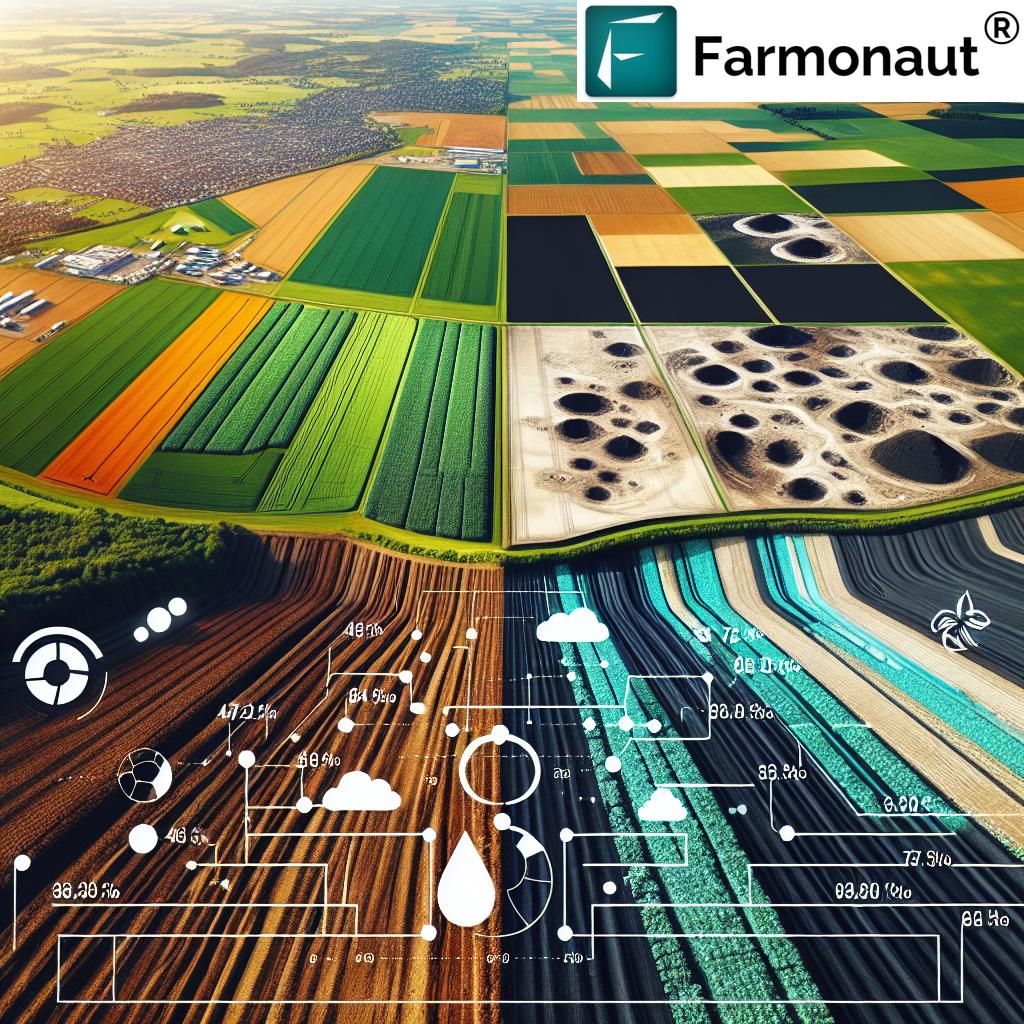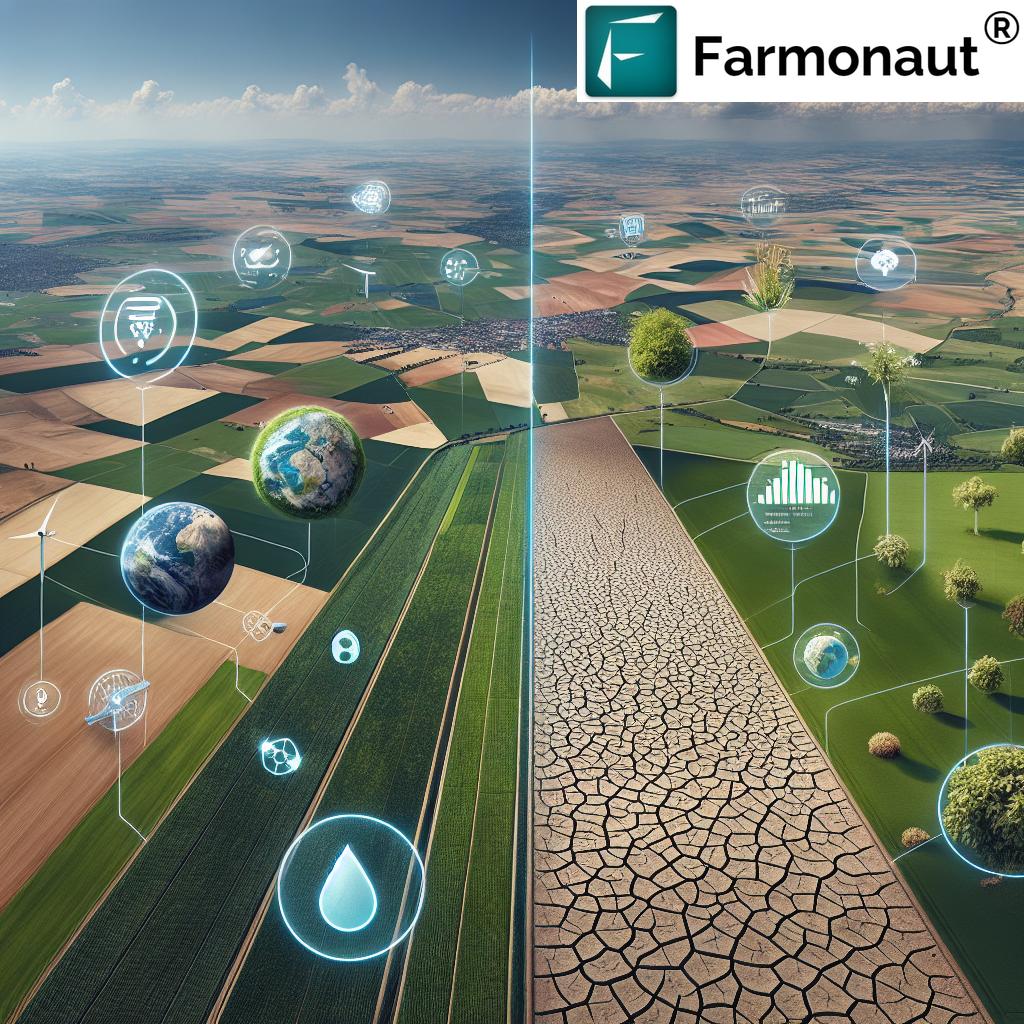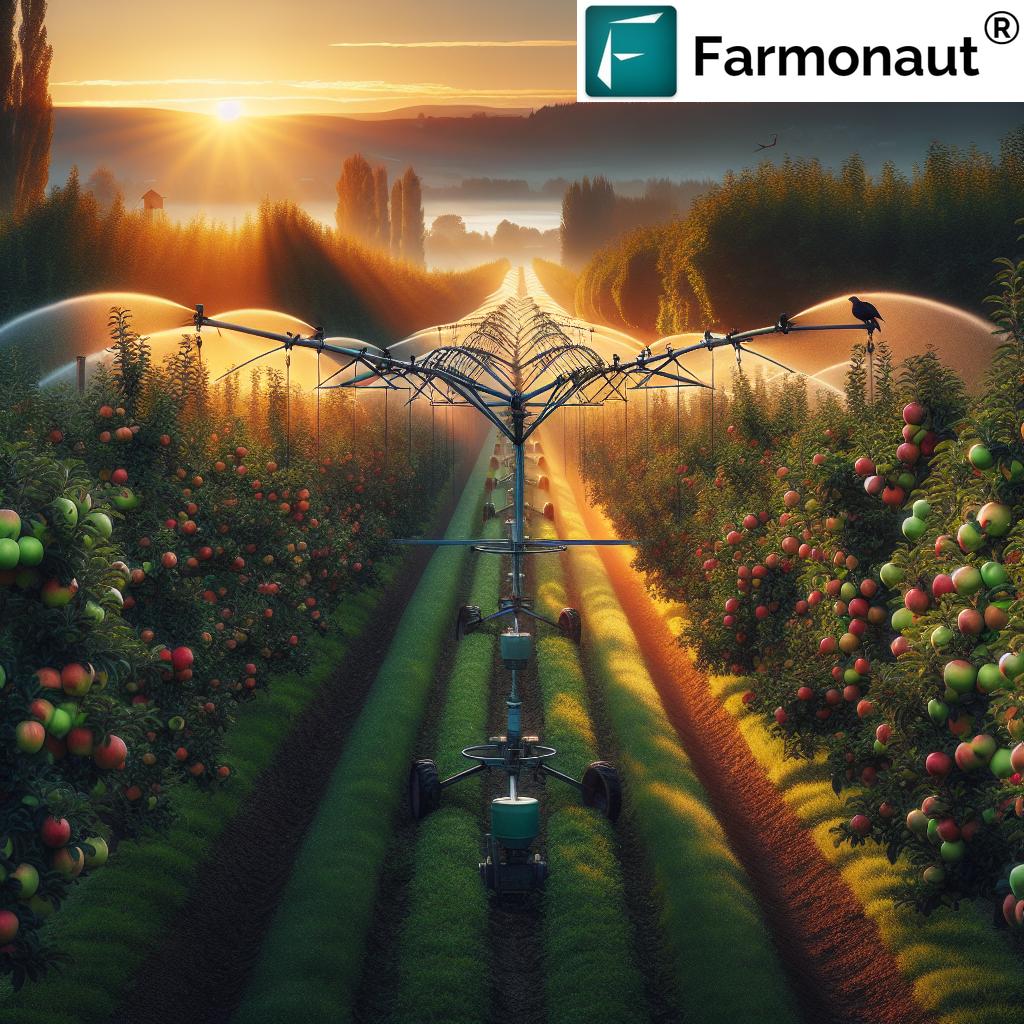Revolutionizing Apple Farming: How Innovative Varieties Are Reshaping South Tyrol’s Fruit Industry
“South Tyrol’s apple industry spans three continents, with production in Europe, America, and South Africa.”
In the picturesque valleys of South Tyrol, a quiet revolution is taking place. The apple, once a humble fruit, is undergoing a remarkable transformation that’s reshaping not just local orchards, but the global fruit industry. We’re witnessing an exciting era where innovative apple varieties are making this classic fruit fashionable again, blending tradition with cutting-edge agricultural science.
As we delve into this fascinating world of apple innovation, we’ll explore how sustainable fruit farming practices and consumer-driven fruit development are revolutionizing apple orchard management. From the sun-drenched slopes of South Tyrol to the vast orchards of America and the fertile lands of South Africa, we’ll uncover the global journey of creating new apple cultivars that are captivating consumers worldwide.
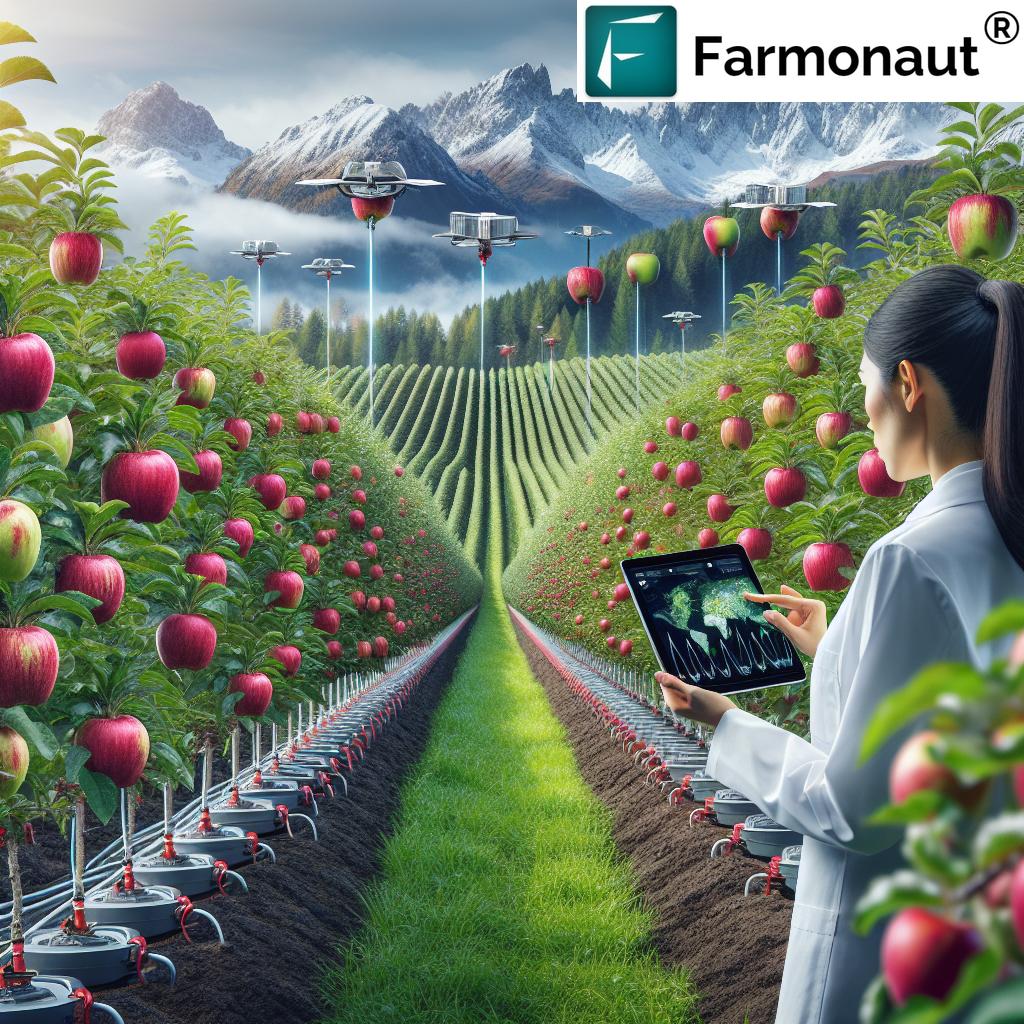
The Renaissance of Apple Farming
The apple industry, particularly in South Tyrol, is experiencing a renaissance. Traditional varieties are making way for exciting new cultivars that promise not just improved taste and appearance, but also enhanced nutritional profiles and sustainability. This shift is driven by a combination of factors:
- Changing consumer preferences
- Advancements in apple breeding techniques
- The need for more sustainable and resilient farming practices
- Growing global competition in the fruit market
As we explore these innovative apple varieties, it’s crucial to understand the role of technology in modern agriculture. Platforms like Farmonaut are at the forefront of this agricultural revolution, offering satellite-based farm management solutions that aid in monitoring these innovative orchards. Through their web app, farmers can ensure optimal growth and quality of these new apple varieties.
The Journey of Creating New Apple Cultivars
The process of developing new apple varieties is a fascinating blend of science, patience, and a touch of serendipity. It often begins with a unique discovery – perhaps a chance seedling or a carefully planned cross between two existing varieties. From there, the journey unfolds:
- Initial Selection: Promising seedlings are identified based on their growth patterns, disease resistance, and preliminary fruit characteristics.
- Testing Phase: Selected trees undergo rigorous testing for several years to evaluate fruit quality, yield, and tree health across different climatic conditions.
- Consumer Trials: Apples that pass initial tests are subjected to consumer taste panels to gauge market potential.
- Commercialization: Successful varieties are then propagated and distributed to growers, often under trademarked names and with specific growing guidelines.
This process, spanning from initial breeding to commercial release, can take up to 20 years or more. It’s a testament to the dedication and foresight of apple breeders and growers who are constantly working to improve and innovate in the world of apples.
Specialty Apple Production: A Focus on Unique Characteristics
“New apple varieties focus on specific traits like red flesh, high vitamin C, and convenient sizing for consumer appeal.”
In the competitive world of fruit production, standing out is key. Specialty apple production has emerged as a strategy to capture consumer interest and create niche markets. These apples are bred and grown with a focus on specific characteristics that set them apart:
- Red-Fleshed Apples: These visually striking apples not only offer a unique appearance but often boast higher antioxidant levels.
- High Vitamin C Content: Some new varieties are specifically bred to have elevated levels of vitamin C, appealing to health-conscious consumers.
- Convenient Sizing: Recognizing the demand for on-the-go snacking, breeders are developing smaller, perfectly portioned apples.
- Novel Flavors: From honey-sweet to tropical hints, new varieties offer flavor profiles that expand the traditional apple taste spectrum.
This focus on specialty characteristics is reshaping the apple industry, creating new market opportunities and changing consumer perceptions of what an apple can be.
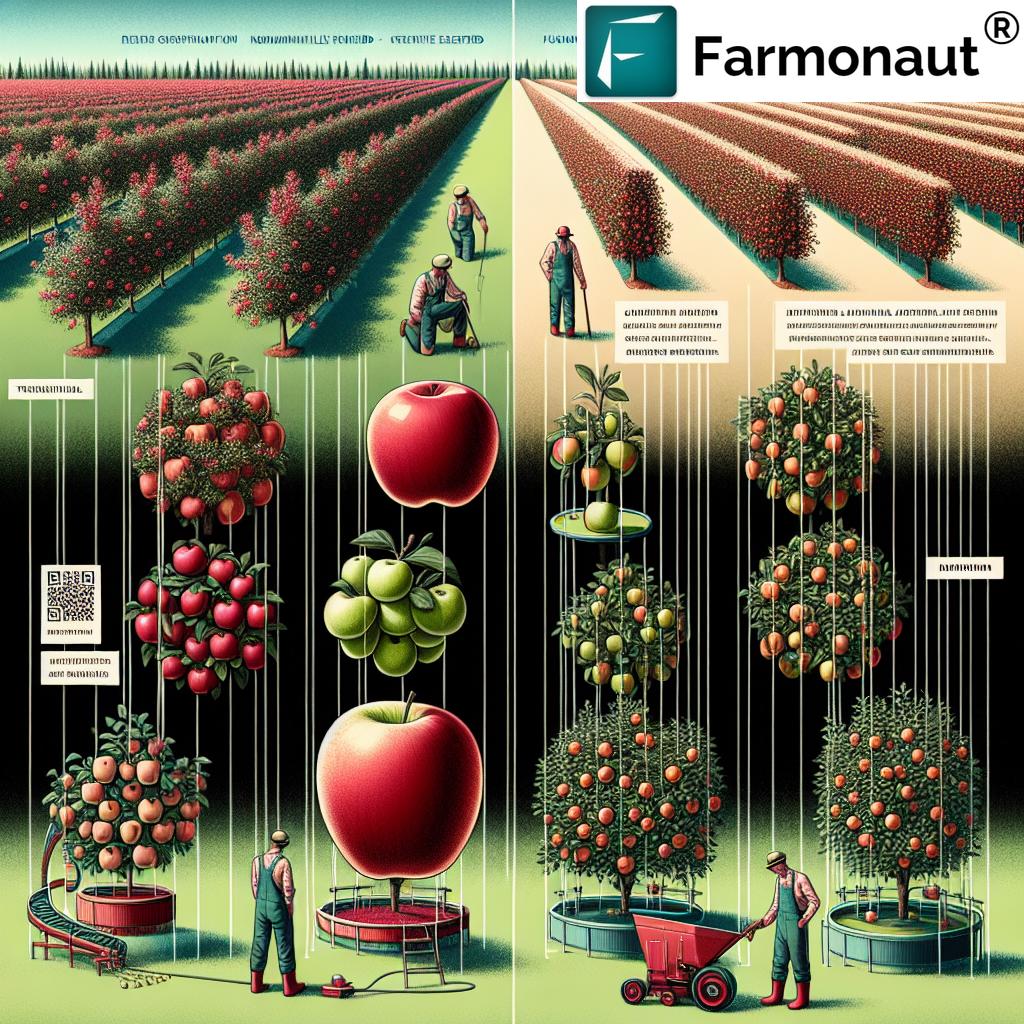
The Global Reach of South Tyrol’s Apple Industry
South Tyrol’s apple industry has expanded far beyond its Alpine roots, establishing a global presence that spans three continents. This expansion is a testament to the region’s expertise in apple cultivation and its ability to adapt to diverse growing conditions:
- Europe: The heartland of South Tyrol’s apple production, known for its pristine mountain orchards and traditional growing techniques.
- America: Collaboration with American growers has led to the introduction of South Tyrolean varieties in key apple-growing states, adapting to different climates and consumer preferences.
- South Africa: The Southern Hemisphere production allows for year-round supply of South Tyrolean apple varieties, capitalizing on counter-seasonal demand.
This global approach not only ensures a steady supply of apples but also allows for continuous refinement of growing techniques and variety development based on diverse environmental conditions and market feedback.
Fruit Marketing Strategies: Making Apples Fashionable Again
In an era where consumers are bombarded with food choices, making apples stand out requires innovative marketing strategies. The fruit industry, particularly in South Tyrol, has embraced creative approaches to capture consumer interest:
- Catchy Taglines: Memorable slogans that highlight unique features of new varieties, such as “Crunch into Color” for red-fleshed apples.
- Brand Ambassadors: Partnering with influencers and celebrities to promote apple consumption as part of a healthy, trendy lifestyle.
- Social Media Campaigns: Engaging content that showcases the journey from orchard to table, appealing to consumers’ interest in food provenance.
- Interactive Experiences: Orchard tours and apple-themed events that create a connection between consumers and the apple-growing process.
These strategies are crucial in repositioning apples from a common fruit to a desirable, fashionable food choice. By leveraging digital platforms and experiential marketing, the apple industry is reaching new demographics and reigniting interest in this classic fruit.
For growers and marketers looking to optimize their strategies, tools like Farmonaut’s API can provide valuable insights into crop health and yield predictions, enabling more targeted and effective marketing campaigns.
Sustainable Fruit Farming: A Core Focus
Sustainability is at the heart of modern apple cultivation, especially in regions like South Tyrol. The industry is adopting practices that not only ensure the longevity of apple production but also appeal to environmentally conscious consumers:
- Water Conservation: Implementing drip irrigation systems and moisture sensors to optimize water usage.
- Integrated Pest Management: Reducing reliance on chemical pesticides through biological control methods and resistant varieties.
- Biodiversity Promotion: Creating habitats for beneficial insects and birds within and around orchards.
- Carbon Footprint Reduction: Adopting energy-efficient practices in cultivation, storage, and transportation.
These sustainable practices are not just good for the environment; they’re increasingly becoming a market differentiator. Consumers are more likely to choose fruits that are grown with eco-friendly methods, making sustainability a key factor in the marketability of new apple varieties.
Evolving Apple Breeding Techniques
The science of apple breeding is continually evolving, driven by advances in genetics and a deeper understanding of consumer preferences. Modern breeding techniques are allowing for more precise and efficient development of new varieties:
- Marker-Assisted Selection: Using genetic markers to identify desirable traits early in the breeding process, significantly reducing development time.
- Gene Editing: Emerging technologies like CRISPR offer the potential for precise modifications to enhance disease resistance or nutritional content.
- Polyploidy Breeding: Creating varieties with multiple sets of chromosomes to achieve larger fruit size or enhanced flavors.
- Climate Adaptation: Developing varieties that can thrive in changing climate conditions, ensuring long-term sustainability of apple production.
These advanced breeding techniques are crucial in meeting the evolving demands of both consumers and growers. They allow for the development of apples that not only taste great but also offer improved shelf life, disease resistance, and adaptability to diverse growing conditions.
For those interested in the technical aspects of modern agriculture, Farmonaut’s API Developer Docs provide insights into how satellite technology and data analytics are being integrated into agricultural practices.
Apple Nutrition Benefits: A Key Selling Point
The nutritional profile of apples has always been a strong selling point, but new varieties are taking this to the next level. Breeders are focusing on enhancing specific nutritional aspects to appeal to health-conscious consumers:
- Increased Antioxidants: Many new red-fleshed varieties boast higher levels of anthocyanins, powerful antioxidants known for their health benefits.
- Enhanced Fiber Content: Some new cultivars are bred to have higher fiber content, promoting digestive health.
- Balanced Sugar Levels: Varieties with naturally lower sugar content are being developed, catering to diabetic and health-conscious consumers.
- Vitamin C Boost: Certain new apples have significantly higher vitamin C levels, enhancing their immune-boosting properties.
These nutritional enhancements are not just marketing gimmicks; they represent a genuine effort to improve the health benefits of apples. As consumers become more nutrition-savvy, these enhanced nutritional profiles are becoming key factors in purchasing decisions.
Production Logistics: Meeting Global Demand
The expansion of South Tyrol’s apple industry to a global scale brings with it complex logistical challenges. Efficiently managing the production and distribution of apples across continents requires sophisticated systems and strategies:
- Cold Chain Management: Implementing advanced refrigeration and storage technologies to maintain fruit quality during long-distance transportation.
- Predictive Analytics: Using data-driven models to forecast demand and optimize production schedules across different growing regions.
- Sustainable Packaging: Developing eco-friendly packaging solutions that protect the fruit while minimizing environmental impact.
- Traceability Systems: Implementing blockchain and other technologies to ensure transparency and food safety throughout the supply chain.
These logistical innovations are crucial in maintaining the quality and freshness of apples as they travel from orchards in South Tyrol, America, and South Africa to consumers around the world. They also play a key role in reducing waste and ensuring that the benefits of these innovative apple varieties reach a global audience.
For growers and distributors looking to optimize their logistics, tools like  can provide valuable insights into crop health and yield predictions, enabling more efficient planning and distribution.
can provide valuable insights into crop health and yield predictions, enabling more efficient planning and distribution.
Consumer-Driven Fruit Development: Listening to the Market
The success of new apple varieties ultimately depends on consumer acceptance. Today’s apple breeding programs are increasingly consumer-driven, with market preferences shaping the direction of variety development:
- Taste Panels: Conducting extensive consumer taste tests to guide selection of new varieties.
- Market Research: Analyzing consumer trends and preferences to identify desirable traits for future apple varieties.
- Customized Varieties: Developing apples tailored to specific market segments, such as children or health-conscious adults.
- Feedback Loop: Continuously gathering and incorporating consumer feedback to refine existing varieties and inform future breeding efforts.
This consumer-centric approach ensures that new apple varieties not only meet agronomic and production requirements but also align closely with market demands. It’s a strategy that has been particularly successful in South Tyrol, where close collaboration between growers, researchers, and marketers has led to the development of several popular new varieties.
Innovative Apple Varieties Comparison
| Variety Name | Origin | Unique Features | Taste Profile | Size Category | Cultivation Challenges | Market Positioning | Sustainability Factor |
|---|---|---|---|---|---|---|---|
| Golden Delicious (Traditional) | West Virginia, USA | Yellow skin, sweet flavor | Sweet with slight tartness | Medium to Large | Susceptible to bruising | All-purpose apple | Moderate water usage |
| RedLove | Switzerland | Red flesh, high antioxidants | Sweet-tart, berry notes | Medium | Limited growing regions | Health-conscious consumers | Resistant to some diseases |
| Cosmic Crisp | Washington State, USA | Long shelf life, crisp texture | Sweet-tart, very crisp | Large | Requires specific growing conditions | Premium snacking apple | Reduces food waste due to longevity |
| Envy | New Zealand | Naturally non-browning flesh | Sweet, low acidity | Medium to Large | Requires careful handling | Gourmet and gift market | Reduces need for anti-browning treatments |
| Arctic Apple | Canada | Genetically modified to not brown | Varies by base variety | Medium | GMO controversy | Convenience and food service | Reduces food waste in processing |
The Role of Technology in Modern Apple Cultivation
As the apple industry evolves, technology plays an increasingly crucial role in ensuring the success of these innovative varieties. Advanced agricultural technologies are helping growers optimize their operations:
- Satellite Monitoring: Using satellite imagery to assess crop health and predict yields.
- IoT Sensors: Deploying sensors throughout orchards to monitor soil moisture, temperature, and other critical factors.
- AI-Driven Decision Support: Leveraging artificial intelligence to provide personalized recommendations for orchard management.
- Precision Agriculture: Implementing variable-rate technologies for more efficient use of water, fertilizers, and pesticides.
These technologies not only improve the efficiency and sustainability of apple production but also help ensure consistent quality across different growing regions. For growers looking to leverage these technologies, platforms like Farmonaut offer comprehensive solutions. Their  and
and  provide easy access to satellite-based crop monitoring and management tools.
provide easy access to satellite-based crop monitoring and management tools.
The Future of Apple Farming
As we look to the future, the apple industry, particularly in regions like South Tyrol, is poised for continued innovation and growth. Several trends are likely to shape the future of apple farming:
- Climate-Resilient Varieties: Development of apples that can thrive in changing climate conditions.
- Automated Harvesting: Advancement in robotic technologies for more efficient and less labor-intensive harvesting.
- Personalized Nutrition: Breeding apples with specific nutritional profiles to meet individual dietary needs.
- Vertical Farming: Exploring indoor apple cultivation to maximize land use and extend growing seasons.
These advancements promise to make apple farming more sustainable, efficient, and responsive to consumer needs. As the industry continues to evolve, the integration of technology and traditional farming practices will be key to success.
Conclusion: A Fruitful Future
The revolution in apple farming, spearheaded by innovative varieties and sustainable practices, is reshaping the fruit industry. From the picturesque orchards of South Tyrol to global markets, these new apples are not just changing what we eat, but how we think about fruit. As consumer preferences evolve and environmental concerns grow, the apple industry’s ability to innovate and adapt will be crucial.
The journey from traditional orchards to high-tech, globally connected apple production is a testament to the industry’s resilience and forward-thinking approach. With continued focus on sustainability, nutrition, and consumer preferences, the future of apple farming looks not just sustainable, but truly exciting.
As we’ve seen, technology plays a vital role in this transformation. Tools like Farmonaut’s satellite-based solutions are empowering farmers to make data-driven decisions, optimize their operations, and produce high-quality apples more sustainably. Whether you’re a grower, distributor, or simply an apple enthusiast, staying informed about these innovations is key to understanding the future of our food systems.
FAQ Section
Q: What makes South Tyrol’s apple industry unique?
A: South Tyrol’s apple industry stands out due to its innovative approach to apple breeding, sustainable farming practices, and global reach spanning Europe, America, and South Africa.
Q: How are new apple varieties developed?
A: New apple varieties are developed through a combination of traditional breeding techniques and modern technologies like marker-assisted selection. The process involves crossing different varieties, selecting promising seedlings, and extensive testing over many years.
Q: What are some of the unique features of new apple varieties?
A: New apple varieties often feature characteristics like red flesh, high vitamin C content, unique flavor profiles, improved storage life, and better disease resistance.
Q: How is technology changing apple farming?
A: Technology is revolutionizing apple farming through satellite monitoring, IoT sensors, AI-driven decision support systems, and precision agriculture techniques. These tools help farmers optimize resource use and improve crop quality.
Q: What role does sustainability play in modern apple production?
A: Sustainability is a core focus in modern apple production, with emphasis on water conservation, integrated pest management, biodiversity promotion, and reducing carbon footprint throughout the production and distribution process.







